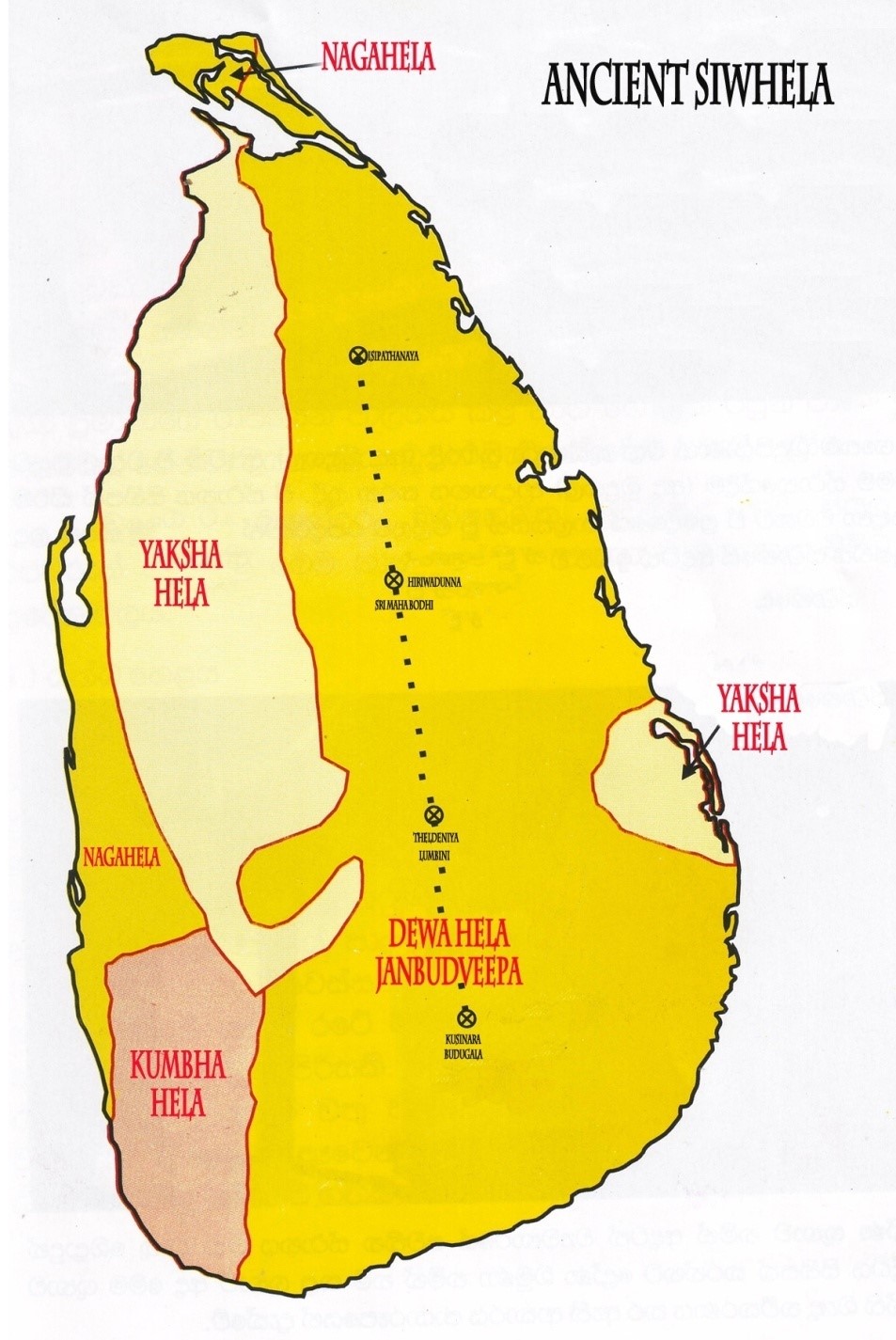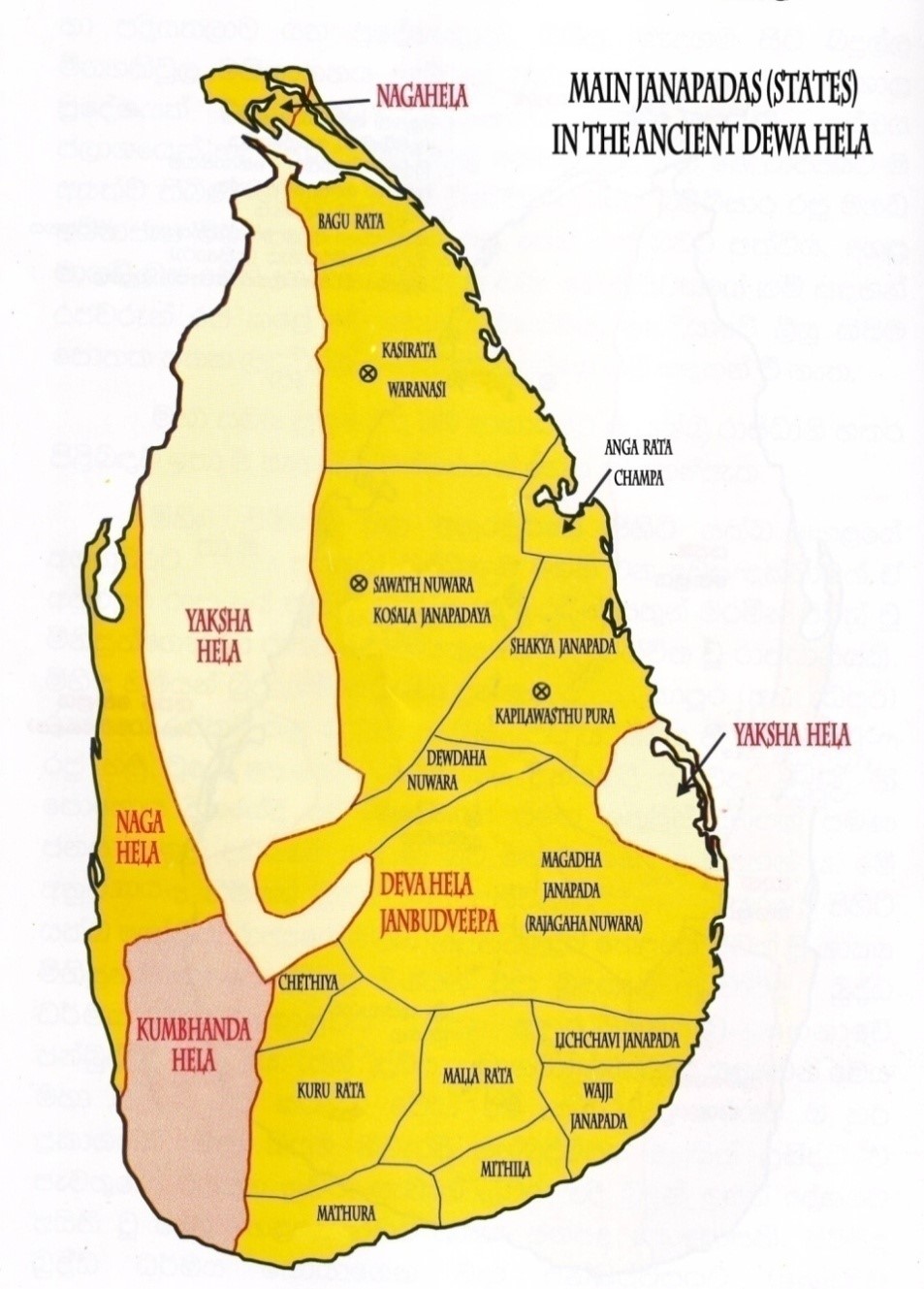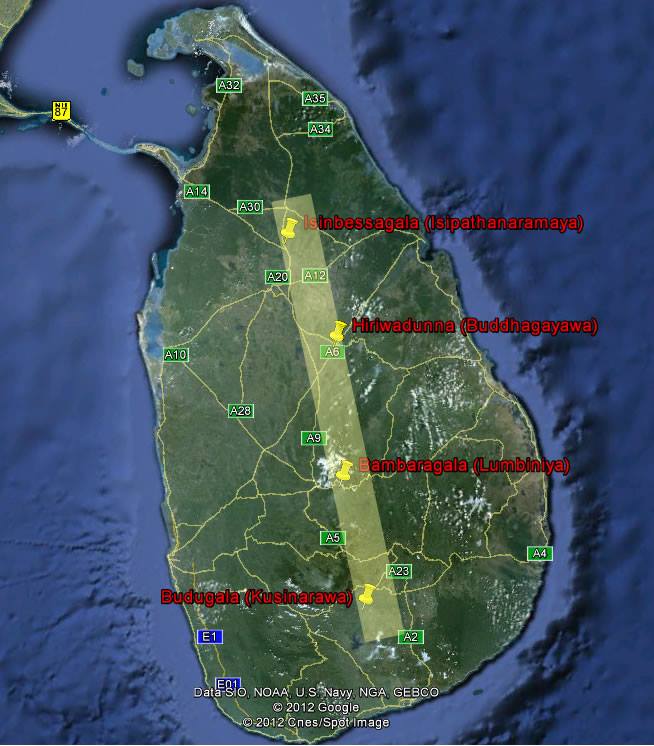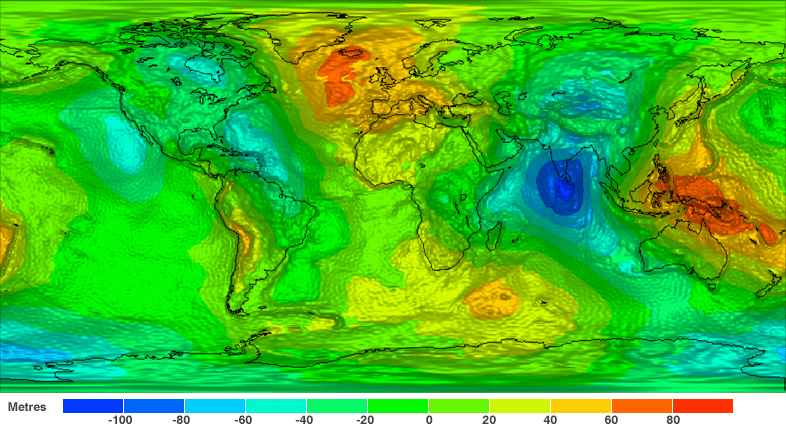If Aaataanaata Sutta and Maha Samaya Sutta in Deeganikaya in Tripitaka, a sermon by Buddha himself, are carefully studied, true & accurate more information about Siw Hela[1] named as Janbudveepa where Gautama Buddha resided and preached his Dhamma, can be discovered. Buddhists can read both these sermons in the pirith potha[2]. And also they can listen to Aaataanaata Sutta every day from the radio. Though these Suttas are heard on daily basis, accurate information about the history mentioned in Magadhi terms, are not explained by any one up to now. Today has become the practice of learnt Bhikkus also of hiding the real meaning of this Sutta claiming that Sutta is meant for chasing out the demons and the spirits.
In order to get a clear picture over our history of Hela Diva, it is necessary to analyze the special historical factors highlighted in both these Suttas found in the pirith potha which is available at every house and listened to the chanting of the Sutta everyone on daily basis. It’s a great mistake to think that these Suttas contain information about a group of some invisible powerful spirits such as demons & Buthas [3] who are weird, miraculous and very extraordinary. Aataanaata Sutta is nothing but a Sutta which is rich in true information and gives a very clear picture about the history of Heladive of Buddha’s time.
Here, it is not expecting to re-write the entire Aataanati Sutta again which is written in Maagadhi language in Tripitaka, but only certain important parts will be analyzed in details.
“ Evan me suthan ekan samayan bhagavaa
raajagahe viharathi gijjakoota pabbathe
athako chaththaaro mahaaraajaa
mahathiyaacha Yakkha senaaya
mahathiyaacha gandhabba senaaya
mahathiyaacha Naaga senaaya
mahathiyaacha kumbhanda senaaya”
One day when the Enlightened One, Gautama Buddha, resides in the monastery in rock called Gijjakoota which is situated closer to the city of Rajagaha, four great kings of the Yakkha tribe mentioned here, came to see the Buddha with their full armies. They had come to see the Buddha for a special discussion, to say something special to the Buddha.
When a ruler of a kingdom or a king goes to an area out of his kingdom for a special matter of this nature, it was the custom in the ancient time to going there with his full armies.
Gijjakoota, the monastery of the rock, the city of Rajagaha where Buddha was living that time and also the kingdom of Yakkha, all these were situated in one country, the island. It is very preciously mentioned in this Sutta. But they were in two different administrative areas. The names of the four kings found in the Sutta such as the king of Kuwera called “Wessawana”, the king of Gandharwa called Dhatharattha, the king of the Naaga tribe called Viroopakkha and the king of Kumbandha called Viroolha are human beings. All in the armies came with these kings are also human beings. They are human beings of each tribe and not the invisible, unknown and extraordinary spirits.
The kings of the four tribes and also the armies came with them were human being who lived in different kingdoms situated in different regions in this Hela Diva in the ancient time.
In the ancient times, Hela Diva was divided in to four different parts, namely, Yakkha Hela, Naaga Hela, Kumbhanda Hela and Gaandharwa Hela. In addition to this there were sixteen Sakyan Janapadas in Janbudveepa which came under Deva Hela. The city of Rajagaha mentioned here was in the Sakyan state called Maghada in Dewa Hela.
In that night, four kings of the Yakkha tribe came to see the Buddha with bright lamps in hand. Like you and me, all of them were human beings. They are our great great grand fathers. They were human beings of a particular tribe lived in our own country in the past.
In the past Thun Helaya[4] had three parts namely Deva Hela, Yakkha Hela and Naaga Hela. Yakkha, Kumbandha and Gaandharwa were the three Yakkha tribal groups lived in Yakkha Hela. They had their own kings. There was one main leader, one main ruler for the four tribes called Yakkha, Naaga, Kumbandha and Gaandharwa. That was the great king, King Kuwera called Wesamuni reigned from the city called Aataanaata. The center of administration and the house of the state of Yakkha Hela were situated in the city of Aaataanaata. It was situated closer to Vilachchiya in Anuradhapura.
In the city of Aataanaataa, at this house of the state which is common to all these four kings of Yakkha Hela mentioned in this Sutta, all the kings and the rulers resolved a commandment called Aataanaataa enactment. These four great kings who made up this commandment came to the city of Rajagaha that night to see Gautama Buddha and informed the Buddha about their commandment, the content of this commandment, how they expect to execute it and the names of forty leaders of the four Yakkha tribes who were empowered to execute this law etc.
King Wesamuni broadly explained the reason for the declaration of the commandment called Aataanaataa to the Buddha.
Following Maghadi words explain it,
1. Saththihi bhanthe ulaaraa Yakkhaa bhagavatho appasannaa
Santhihi bhanthe ulaaraa Yakkhaa bhagavatho pasannaa
2. Saththihi bhanthe majkhadima Yakkhaa bhagavatho appasannaa
Santhihi bhanthe majkhadima Yakkhaa bhagavatho pasannaa
3. Saththihi bhanthe neechaa Yakkhaa bhagavatho appasannaa
Santhihi bhanthe neechaa Yakkhaa bhagavatho pasannaa
Yebhuyeyna kho pana bhanthe Yakkha
appasnnaa yecha baghavatho
than kissa hethu
bhagavaahi bhanthe paanaathipaathaa veramaniyaa Dhamman desethi
adinnaadaanaa veramaniyaa Dhamman desethi
kaamwsu michchaachaaraa veramaniyaa Dhamman desethi
musaavaadaa veramaniyaa Dhamman desethi
suraameraya majjipamaa datthaanaa veramaniyaa Dhamman desethi
Yakkhaa appatvirathaa yecha
paanaathipaathaa, appatvirathaa, adinnaadaanaa appatvirathaa
appatvirathaa kaamwsu michchaachaaraa
appatvirathaa musaavaadaa
appatvirathaa suraameraya majjipamaa datthaanaa
“ the san than hothi appiyan amanaapan”
King Wesamuni spoke to Gautama Buddha. Thus,
“Oh, most venerable Sir, some powerful Yakkhas who live among our subjects in the Yakkaha tribe respect the Buddha and his disciples with pleasant mind and thoughts, pay their homage to them. But some are not so, they act in a manner of disturbing the disciples of Buddha with unpleasant mind and thoughts.
Some of our own people with middle powers in the Yakkha tribe respect and treat the Buddha and his disciples with pleasant mind and thoughts. But some people of Yakkha with middle powers act in an unpleasant manner towards the Buddha and his disciples. It is a disturbance to the disciples of the Buddha.
Further, some low and inferior people in the Yakkha tribe also treat the Buddha and his disciples with honor and pleasant manner. But some low and inferior people of Yakkha tribe do not act in that manner.
There is a special reason for some of them to be interested in Buddha and some of them to be unpleasant in Buddha.
Most venerable Sir, your disciples always preach the good about Pancha Seela. They advice the people to follow Panch Seela. Your disciples preach our people not to harm animal life, not to steal from others and not to take intoxicating drinks.
But, most venerable Sir, a majority in our tribal community goes for hunting, harms animal life, goes for fishing and do it as a live hood. They are not worried about cultivating grains. They are not a group of people who work in the paddy fields with the plough, manage waters and do animal husbandry for living. They steal. Some of them are extremely vicious and may go to the extent of killing humans and eating their flesh. They take intoxicating drinks. The people of this nature are not interested in Buddha Dhamma preached by your disciples. They cannot follow that Dhamma. Some people in our Yakkha tribe have inhumane qualities. They have the qualities which cannot be expected from human beings. Hence, most venerable Sir, people of our Yakkha tribe having this kind of low qualities cannot be controlled by the Dhamma preached by you or your disciples. The way of Dhamma does not suit for them. They cannot understand the Dhamma.
In our king’s court situated in Yakka Hela in the city of Aataanaataa, we discussed all these things in details and we resolved the following enactment in the king’s court. Most venerable Sir, we came here in this manner to inform you the things we resolved. The great King Wesamuni requested in humbly manner from The Enlightened One to spread out this information to his disciplines and ask them to act accordingly.
“This is the enactment, the commandment of Aataanaataa”. King Wesamuni further informed the Buddha that, in order to execute this commandment, he would appoint forty regional Yakkha leaders as administrative officers who respect the disciples of the Buddha, who are interested in them and who know Dhamma. These forty administrative leaders in the Yakkha tribe will safe guard the boundary lines in the Deva Hela & Yakkha Hela, especially, places like Aranya Senasanas, caves, jungles, huge trees & tree-shelters where the disciples of the Buddha practice mediation & the code of Dhamma. They are given the required administrative authorities of the king to chase out the evil people in the Yakkha tribe who kill men and eat flesh, also to secure the required safety of the disciples of the Buddha. The very moment that any complaint goes to these regional leaders, they will act immediately, punish the offenders and safe guard the disciples of the Buddha. If there is any trouble or inconvenience, please inform them with a louder call.”
With regards to these facts there is a fable also in the Aataanaataa Sutta.
“ Seiyathaapi maarisa ranno maagassa
Vijithe chooraa, the newa ranno
Maagadhassa aadiyanthi na ranno maagadassa
purisakaanan aadiyanthi,the kho the maarisa
mahaa choraa, ranno maagadassa
awaruddha nama vuchchanthi
ewa mewa kho maarisa santhihi
amanussa chandaa rundaa rabhasaa
the newa mahaaraajaanan aadiyanthi”
King Wesamuni also informs Buddha that “ Me, the great ruler of the Yakkha Hela, irrespective of the status, powers, relationships or any other reasons would punish all the members of Yakkha tribe within our territory who do unwholesome acts, unfair things, steal and disturb the disciples of the Buddha of Yakkha in the same way how the great king of Maghada, where the city of Rajagaha also coming under, excessively punishes the robbers, the great robbers & the bandits irrespective of their status, ranks or any other reasons.
Here, King Wesamuni takes the great king in Maghda as an example, as a fable. Maghada, ruled by a Sakyan king of Maghada, was one of the sixteen states in the Deva Hela of which city of Rajagaha was the capital city. The meaning of this is that the kingdom of Maghada was situated near the border of Yakkha Hela.
When the time that the great King Wesamuni presented the Aaataanaataa enactment to the Buddha, he had clearly explained certain things such as information of other three kings who came with him, respective areas that they ruled, the directions of areas ruled by each king, citizens of these kings and their way of life etc. This information is broadly explained from seventh stanza to the 31 stanza in the Aataanaataa Sutta. This explains the kingdoms of Yakkha existed in Hela Diva in the ancient time and also the directions of each kingdom. There is another Sutta in the Tripitaka which gives a lot of clear information about this. That is the Mahaasamaya Sutta. Following the clear explanations of these two Suttas, it is better to draw up a map on the ancient Hela Diva and explain this matter.(see the no 1 map of Lanka).
According to the explanation given that day by the King Wesamuni, Siw Helas in the ancient Lanka are as follows.
1. Gandarva Hela
King of Gaandarva called King Dhatharatta ruled Gaandarva Hela and it was situated bordering to the sea on the east direction of the city of Rajagaha. This kingdom wakes up with the sun rise in the north, situated in the purimaa direction (east direction), and was dwelled by the people of Gaandarva tribe. Fairly a large area came under Gaandarva Hela, stretching from the Thoppigala jungle to Batticaloa & Ampara districts, as the names given in today’s context. This Yakkha Hela dwelled by the Gaandharva tribe was situated on the east direction of Gijjakoota parvatha, where Buddha resided. Thoppigala was the capital city of Yakkha Hela.
2. Kumbhaanda Hela
This kingdom, the dwelling place of Kumbhaanda tribe, was situated to the south of the city of Rajagaha and ruled by King Viroolha. Here, people eat raw flesh & fish, are extremely barbarians who would skin off humans and eat their flesh, kill animals for living, steal from others and take intoxicating drinks and consist of dangerous robbers and bandits. Their qualities are not of human beings. So they behave as demons.
Some parts in the districts such as Colombo, Kaluthara, Rathnapura & Galle, a large forestry area including today’s Sinharaaja forest were coming under Kumbhanda Hela.
3. Naaga Hela
An area adjoining the great sea, situated on the west direction (pachchima disaa) to the city of Rajagaha was Naaga Hela and ruled by King Viroopakkha. Their livelihood was fishing. Some people in the Naaga tribe were in to trading in the sea as well. Villages and cities in the western coastal areas from Kalpitiya to Galle, as they are named today, were mainly coming under the Naaga Hela. A place in between Kelaniya & Negambo was the capital city and King Viroopakkha ruled his country from there. There had been many regional kings of this kingdom of Naaga, the Tripitaka says. All the villages such as Naagadeepa, Nainathiew and Nainamadama, as we call them today, were coming under Naaga Hela. Even in some interior parts, there had been some small kingdoms ruled by kings of Naaga tribe. Betel[5] was grown in Naagadeepa.
All the kings such as Choolodara, Mahaaudara, Maniakkhitha and Muchalinda ruled the different places where people of Naaga tribe lived.
4. Yakkha Hela
The great King Wessawana was the ruler of Yakkha Hela. This great King of Yakkha tribe was the chief leader of all other tribal kings as well. Hence, the great King Wessawana was the king for all four tribal communities in the whole island, namely, Yakkha, Naaga, Kumbhaanda and Gaandarva. The city of Aataanaataa was his centre of administration. Aalakamandawa (later Lankaapura) was a main city where the great King Wessavana had his royal palace. The people of this country of Yakkha were a group who did hunting, eating flesh and fish. As it was mentioned by the King Wesamuni, people in his county did not cultivate paddy. They did not use the plough and cultivate paddy fields. They ate yams, different leaves and grains gathered from the jungle. Mannar in Poonarin in Jaffna, districts like Anuradhapura, Putthlam & Kurunegala and also some parts in the Kandy & Matale districts came under Yakkha Hela and of which, in the ancient times, Aalakamandawa & Aataanaataa were the two main capital cities. (See the map). In the past, all the places up to Alawwa in Kurunegala district were coming under Yakkha Hela. Demon Alaw [6](Aalaw Yaka) was subjugated by Buddha in this place called Alawwa, as we call it now. In the past this place too came under the reign of the great King Wesamuni. Uthuruku Divaina was another name given for this Yakkha Hela. The city Aalakamandaa was in the place called Mahavilachchiya or Vilachchiya today. In the past, the city of Aalakamanda was situated around a large natural water reservoir. Later, the history says that King Vijaya came to Lanka, with the support given by Kuveni, killed 80 princes of the Yakkha tribe and conquered the Yakkha Hela. What he captured was city of Aalakamandaa. It was popular, that day, as Lankaapura[7] as well. This city got this name, Lankaapura, purely because of its beauty.
The King Wessavana brought it to the notice of Gautama Buddha that he had appointed forty regional leaders of the Yakkha tribe who are capable enough to safe guard the boundaries of the Yakkha Hela, also have the utmost faith & respect towards the disciple of the Buddha and would act accordingly. Names of these forty leaders are also found in the Aataanaataa Sutta.
That day King Wessawana informed Gautama Buddha that he appointed these regional leaders of Yakkha, namely, Indra, Soma,Waruna, Bhaaradwaja, Pajaapathi, Chandano, Kaama Settho, Kinnugandu, Nigandu, Panaado, Opamanno, Dewasuthoo, Maathali, Chiththaseno, Gandhabbanalo, Raajaajanosabho, Sathaagiro, Hemawatho, Punnako, Karathiyo, Gullo, Seewako, Muchalindo, Wessamiththo, Yugandharo, Gopaalo, Suppagodho, Hirineththi, Mandiyo, Panchaalachancho, Aalawako, Pajjunno, Sumano, Sumukho, Dadhimuko, Manimaanicharo, Deegho, Atho, Serissako to safe guard the boundaries, to stick on and to execute the enactment of Aataanaataa.
Buddha carefully listened to all these and accepted the facts presented by King Wessavana. Later, Buddha assembled all his four types of disciples, namely, Bhikkhu, Bhikkhuni, Upasaka & Upasika [8], preached about this enactment of Aataanaata, methodology of it and all the names of the Yakkha leaders appointed to safe guard it. Because of this, the Aataanaata commandment consented at by King Wessavana at his court, later became a commandment of Buddha too.
Today, this is the reason for Aataanaataa Sutta to be appeared twice in the Pirith Potha and in Tripitaka as well, the command of the king and the commandment of the Buddha.
The Aataanaata Sutta in this nature was preached to people. Its content is about people. All those tribal people lived in this Hela Diva. Gautama Buddha too lived in this Deva Hela.
Now, Gijjakoota Parvatha[9] and the city of Rajagaha, mentioned in Aataanaataa Sutta, where the Buddha lived can be discovered from this Hela Diva itself.
The area stands like a circle of great rocks, namely, Rajagala, Nilgala, Buddhangala & Nuwaragala in the districts like Ampara, Badulla and Monaragala in today’s context, came under the kingdom of Maghada. Gijjakoota Parvatha too was situated in the same location of Veluvanaaraamaya which is closer to city of Rajagaha. This was situated to a place closer to the capital city of the kingdom of Maghada. Earlier, a large area like Uhana, Bakkiella, Gonaagalla, Mahaoya & Padhiyathalaawa in Ampara district today, Bibila, Maddagama to Badulla, Meegahakiwla & Mahiyanganaya and Maddagama to Akkarapaththuwa came under kingdom of Maghada. All the paddy fields which are cultivated today with the waters of Galoya reservoir too came under this same kingdom. In Gautama Buddha’s time King Bimbisaara was the emperor in Maghada. Later King Ajaasaththa came in to power. Hela Magadhi was the language used here. All of these kings found in Tripitaka reigned in this Hela Diva. In any book, paper or document written in India, names of these kings cannot be found.
Same as here, even in Maha Samaya Sutta, a very clear description on four Yakkha kingdoms, is given.
Until Buddhism was introduced to the capital city of Yakkha Hela in Anuradapura (to Lankapuar) by Arahant Mahinda Thero, the kingdom of Anuradhapura was such that the state leader and the people had the habit of going on hunting and killing animals in the wild. Arahant Mahinda Thero introduced Buddhism to King Dewana Paa Thissa who was the leader of Lankaapura (Anuradapuar) by that time. Arahant Mahinda Thero met King Tissa in a Poson Poya[10] day. The Mahavamsa says that even in the Poson Poya day forty thousand people had gone for hunting with their king to the wild. It is clear then Arahant Mahinda Thero introduced Buddhism to the people in Yakkha tribe in Anuradapura and not to the Sakyan people in the Deva Hela. Venerable Mahinda Thero brought the Buddhukeli Commentaries and Buddha Dhamma to Lankaapura (Anuradhapura then) from Janbudveepa. This is stated in Mahavamsa as Jambudveepaa Idhaagatha Lankapura. This note is preciously correct. It was the sixteen Sakyan states, including city of Sawath & city of Rajagaha, in Deva Hela was popular as true and real Janbudveepa where Buddha was born. It is very clear that Arahant Mahinda Thero came to Janbudveepa (the city of Rajagaha in Hela Diva) in search of supermandane Buddha Dhamma, learnt Buddha Dhamma & Hela language there, attended to the Arahantship, first introduced Buddha Dhamma and later Buddhism to non-Buddhist kingdom in Anuradapura. Arahant Mahinda Thero came to Janbudveepa and learnt Buddha Dhamma in the city of Rajagaha. That was Rajagala in Ampara. The history says that after the cremation of Arahant Mahinda Thero, the deposit of his ashes had been discovered from this place. Because of this, what is mentioned in Mahavamsa, “ jajbuddeepaa idhaa gathaa Lankapura”, is true. When the time Mahavamsa was written in Hela, Janbudveepa was in Rajagala in Ampara. Lankapura was Mahavilachchi near Anuradapura. According to this, Bhikkuni Sangamiththa brought in the right branch of the sacred Sri Maha Bodhi from Janbudveepa to Anuradhapura. That is also true. Hirivadunna now was a place in Janbudveepa in the past. A branch of the Bo tree was taken from there to Anuradhapura in a boat.
Janbudveepa means the island where Buddha was born and all the future Buddhas will be born. In Aataanaataa Sutta, King Wesamuni explains to Gautama Buddha that four Buddhas in the past had been born here in Janbudveepa and the ancestors in King Wesamuni’s family had an unbroken custom of paying homage to all those Buddhas. Its proved that this Hela Diva which is popular as Janbudveepa has the universal energies which had help for the supreme Enlightenment of all the Buddhas in the past and will help all the Buddhas in the future too.
[1] Four Hela.
[2] Pirith is the Sinhala word for paritta (in Pali), which means protection. “It protects one from all directions”, is the traditional definition. This is the recitation or chanting of the words of the Buddha. Pirith potha is the book which contains pirith.
[3] Ghosts, spirits. According to Buddha they are different creatures living under extremely poor conditions such as limitation of food & drinks, clothing , shelter etc. They get in to worlds of this nature due to the evil acts performed by them in their past lives. To overcome this situation, they expect humans, probably their own past relations who are human beings now, to do meritorious acts and pass the merits on them.
[4] Thun Helaya( Three Helas) is another name for Lanka.
[5] Betel or Bulath – is the leaf of a vine belonging to the Piperaceae family. It is valued both as a mild stimulant and for its medicinal properties. Betel leaf is mostly consumed in Asia with or without tobacco, in an addictive psycho-stimulating and euphoria-inducing formulation with adverse health effects. Betel leaves are used in many occasions in Sri Lankan culture and people believe that they got Betel from Naa Lova, the world of Naa or Naga.
[6] The word demon was used here as in its general use. Demons in English language are spirits, but not Yakkhas and can not be used in place of the tribal group of Yakkhas found in Lanka. Presently in the common use word Yakkha is replaced with demon which is totally wrong.
[7]Lanka – beautiful, attractive. Pura – the city.
[8]Bhikkhu is an ordained male Buddhist monastic. Bhikkhuni is a female Buddhist monastic. Upasaka is a male lay Buddhist. Upasika is female lay Buddhist.
[9] The rock called Gijjakoota.
[10] The full moon poya day in June. Buddhists consider this day as the day that Arahant Mahinda came to Sri Lanka from India and introduced Buddhism to them. They commemorate this day with religious activities.





